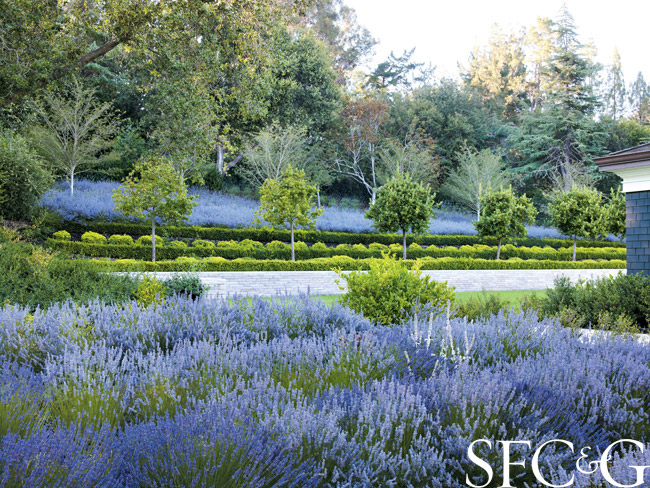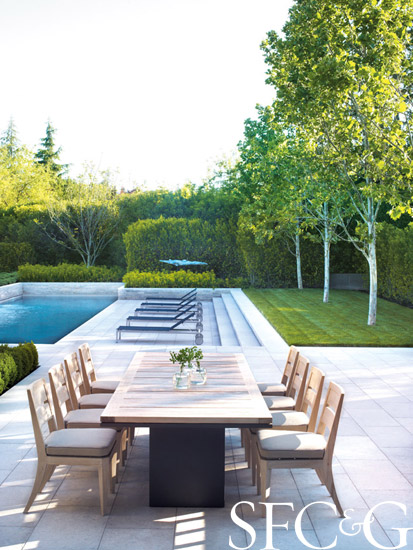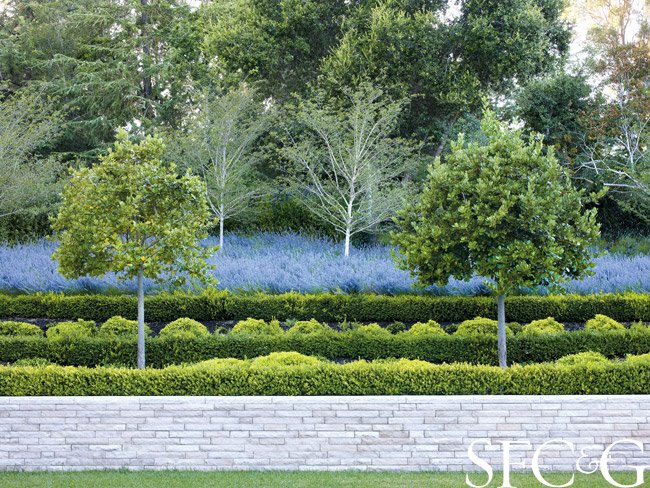
San Francisco Cottages Gardens / May 2014
By Linda O’Keeffe
Photography by Marion Brenner

There’s a historical complexity that underlies Andrea Cochran’s cool modernism. “When I was in my twenties, I toured the Villa Giulia outside of Rome,” says Cochran, “and the principles of its Renaissance garden—beauty derived from order; visual enticements guiding the eye from one space to another; discovery; the notion of surprise—have been foundational to the work I’ve done ever since.” These influences can be seen playing out in environments designed by her award-winning, eponymous San Francisco firm, whose landscapes are noted for their intelligent, elegant formalism.
Cochran most recently applied those principles to transform the unstructured grounds of an Atherton residence into a sublime formal garden. On the first visit to the home, designer and her associate, Emily Rylander, were confronted with a sloping terrain where random patches of hedge, a conventional lawn, an unused playhouse, a brick patio and a painted wood trellis were all held hostage by a circular driveway. “Everything leapt out at you,” says Cochran. “There was no ‘there’ there.”
Andrea Cochran Transforms the Grounds of an Atherton Property into a Sublime Formal Garden
 In collaboration with the homeowner, who played a pivotal role in the garden’s design and installation, she began bringing order to chaos throughspatial organization. Cochran designed a rectangular series—a 55-foot-long pool, a 125-foot-long play lawn and an allée of linden trees—to de-emphasize the house’s irregular footprint. “I’m a formalist at heart, but it’s never a question of taming nature; it’s a question of coaxing it,” she explains. The result is a series of handsomely proportioned, plein-air living spaces with intriguing vistas that beckon from every direction.
In collaboration with the homeowner, who played a pivotal role in the garden’s design and installation, she began bringing order to chaos throughspatial organization. Cochran designed a rectangular series—a 55-foot-long pool, a 125-foot-long play lawn and an allée of linden trees—to de-emphasize the house’s irregular footprint. “I’m a formalist at heart, but it’s never a question of taming nature; it’s a question of coaxing it,” she explains. The result is a series of handsomely proportioned, plein-air living spaces with intriguing vistas that beckon from every direction.
Through boxwood hedges and low, limestone walls, one gets a teasing first glimpse of the site’s beautifully orchestrated color. The view varies with the seasons: Spring’s pink and black hellebores yield to summer’s crop of yellow-green hydrangeas and a glorious lavender hillside; fall sees the gingko trees turn brilliant yellow before bright red berries appear in wintertime on the hawthorn trees. Sound is another element that Cochran carefully choreographed.The occasional din of a distant leaf-blower or lawn mover is neutralized by the sound of water as it cascades down a 14-foot-wide black basalt wall, or spouts, fountain-like, into the sunken pool. The experience of the garden, Cochran explains, “draws upon all of the senses.”

Andrea Cochran Transforms the Grounds of an Atherton Property into a Sublime Formal Garden
“Appreciating a garden isn’t generally a sedentary pastime,” continues the architect, who considers her work to be as much about kinesiology as it is horticulture. In fact, the way she analyzes whether a path should be negotiated with a stroll or a stride, or places a plant exactly where the fragrance released by its spiky whorl will intoxicate a passerby, links her to artists like Bruce Nauman and Robert Irwin, whose built environments transform a simple movement from A to B into an exploratory act of passage and arrival.
“Sometimes I revisit a project and redesign everything in my head,” says Cochran, who’s currently at work on numerous landscapes, including the Windhover Contemplative Center at Stanford. “But when I come back here, it feels right just as it is—so much so that I don’t want to leave.”
A version of this article appeared in the May 2014 issue of San Francisco Cottages & Gardens with the headline: Lavender Infusion.